![]()
Budget 2004 - Budget
Plan
- Table of Contents - Previous
- Next -
Annex 7
The Importance of Productivity Growth to the Long-Term
Well-Being of Canadians[1]
The Government’s key objective is to improve the well-being of Canadians
A key objective of the Government’s policy is to increase the well-being of all Canadians. The well-being of Canadians is a concept that encompasses our standard of living, our social goals, our environment and our security. These goals need not conflict. For example, enhanced growth in income enables increasing expenditures on health care, education and other social programs, thereby also contributing to Canadians’ well-being. In the best of circumstances, economic and social policies are complementary. For instance, improved education enables individuals to play a fuller role in society; at the same time, more educated individuals generate the new ideas that foster growth in income.
In recent years Canada has been successful in raising living standards through both employment and productivity growth. However, looking ahead 10 years, it will be increasingly difficult to continue to improve living standards through increased employment, because of shrinking of the working-age population. Aging population will also lead to greater pressures on pensions and health care expenditures. To lessen this burden, one of the critical tasks facing Canada over the rest of this decade is to increase productivity growth so that living standards continue to rise.
To increase productivity requires more investment in the drivers of productivity growth: human capital, physical capital and innovation. Most of these investments are made by individuals and businesses. For its part, the Government must enhance and strengthen its policy framework to encourage all Canadians to invest more in these drivers.
Improvements in standard of living come from either productivity growth or employment growth

- While there are many indicators one can use, gross domestic product (GDP) per person is probably the best single indicator of standard of living.
- Broadly speaking, there are two ways to raise the standard of living:
- Increase how much each employed worker produces—productivity.[2]
- Increase the share of the population that is working—the employment-to-population ratio.
Canada’s productivity performance has improved markedly
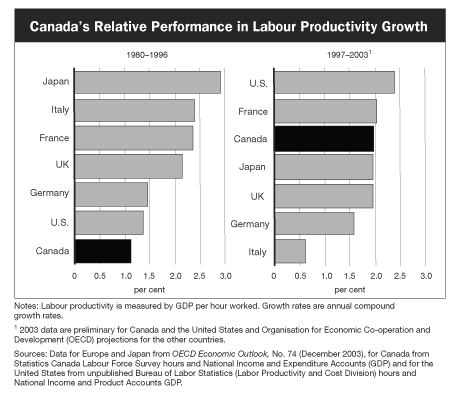
- Canada’s recent productivity growth performance has been impressive. The last time the Canadian productivity growth rate was higher than in the 1997–2003 period was during the 1960s.
- Even though growth in productivity has picked up since 1997, prior lacklustre performance means that the actual level of productivity in Canada remains lower than in the U.S. But this gap also shows that Canada has an opportunity to further increase productivity and in turn our standard of living.
The employment-to-population ratio has also increased
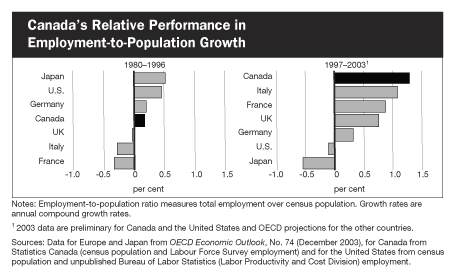
- The proportion of Canada’s population with jobs has increased substantially and now exceeds the U.S. level.
- The strong contribution of employment to GDP per capita growth in Canada comes from two factors: the proportion of working-age Canadians who have jobs is at a record high, and working-age Canadians make up a greater share of the population than ever before.
- However, with the aging of the population, the proportion of the population that is of working age will start to decline by 2010.
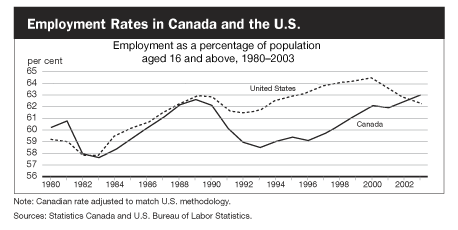
As a result, Canada’s standard of living has improved dramatically since 1997
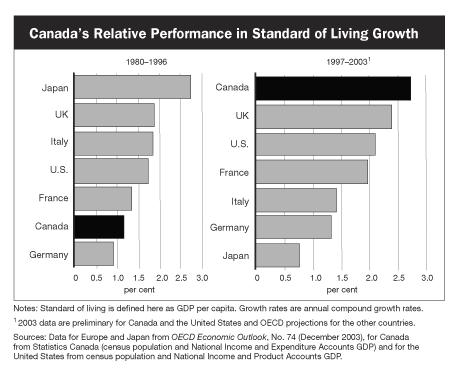
- Canada’s standard of living growth has been the fastest in the G-7, and one of the best in the industrialized world, since the Government first balanced the budget in 1997–98. By contrast, Canada had one of the worst performances over the 1980–96 period.
- As noted above, both strong productivity and employment growth have contributed to Canada’s much-improved standard of living performance. Since 1997, Canada’s standard of living has grown by 2.7 per cent per year.
Despite the substantial rise in Canada’s standard of living, a gap with the U.S. remains
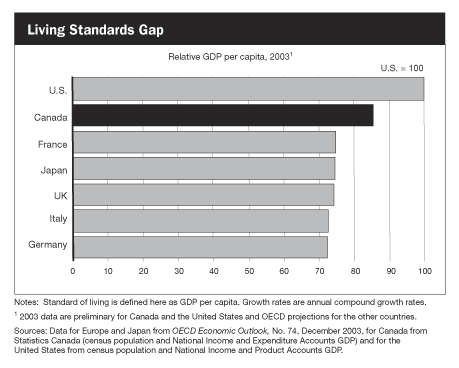
- Canada’s impressive growth since 1997 has led to a marked increase in Canadians’ standard of living: Canada has moved up from seventh in the OECD in 1996 to fifth in 2003 and second in the G-7. This growth has narrowed Canada’s standard of living gap with the U.S. from 18.1 per cent in1996 to 14.5 per cent in 2003.
- With higher employment rate levels in Canada than in the U.S., the standard of living gap with the U.S. is a direct function of the difference in the level of productivity.
Looking ahead, a higher standard of living will have to come from productivity growth because of population aging

- The aging of the population will exert downward pressure on the employment-to-population ratio over the coming decades. Projections show that the proportion of the population aged 15 to 64 will begin to decline in 2010, leading to an inevitable fall in the percentage of the population that is working.
- With continued economic growth and policy adjustment, there is still some scope to further increase the proportion of working-age Canadians who have jobs. However, population aging means that it will become increasingly difficult to continue to increase the employment ratio in the future.
- This implies that continuing to boost productivity growth will be crucial if we are to continue to increase our standard of living in the future.
To increase our standard of living, Canada must concentrate on the key drivers of productivity growth

- The goods and services we consume are produced by workers and equipment, which come together with the available technology. How well people and physical capital interact within the economy to produce these goods and services is measured by productivity.
- Productivity can be improved directly through higher investment in both physical and human capital. Investments in more education and better skills—human capital—allow workers to be more efficient and effective. Workers can also produce more goods and services if they can work with more and better equipment.
- Larger investments in human and physical capital also raise productivity levels indirectly through increased innovation. Innovation—new ideas—provides better ways of producing existing goods and services: it improves the technology being used. This improved technology allows workers and equipment to coalesce in novel ways to increase output.
- Innovation not only means finding better ways to produce existing goods and services; it also provides the opportunity for new goods and services to be developed.
- These drivers of innovation reinforce each other. Innovation produces new ideas that may be embodied in new physical capital, which in turn can be exploited by skilled workers to increase productivity.
International evidence supports the importance of these productivity drivers
|
Quantifying Growth Drivers—The OECD Growth Study Impact of Drivers on GDP per capita level in steady state
|
||||||||||||||||||||||||
- An OECD study provides strong empirical support of the importance of these drivers of growth. These drivers have long-term impacts on standard of living.
- The above chart shows how a particular change in each of the drivers of growth impacts on the standard of living. For example, international experience suggests that adding one year to the average educational attainment in a country can increase its level of GDP per capita by more than 5 per cent.
- Given that all of these drivers are important and interact with each other, it is crucial for Canada to encourage investment in all of the drivers of growth.
Canada does very well in the area of human capital …
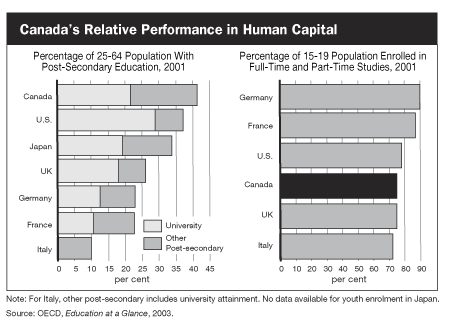
- Human capital is one of the key drivers of productivity growth. More human capital allows workers to bring new skills to bear and make better use of equipment, and hence have higher earnings.
- But workers with greater skills—human capital—are also an important source of new ideas that can increase innovation. There is no precise way of measuring human capital but the average level of education can approximate it.
- Canada does very well on the human capital front: Canadians are among the most highly educated in the world and perform well on international tests.
- But there is more to human capital than having post-secondary education. It is also vitally important that all Canadians attain the best quality education performance at every level. On this front, the relatively high dropout rate from high school is a concern.
- At the higher end of education, Canada has proportionately fewer university graduates with degrees in sciences than many other OECD countries.
… but invests less in physical capital …
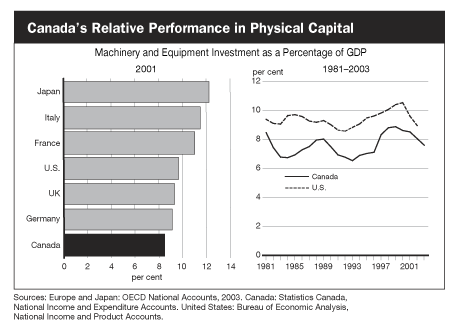
- More physical capital allows workers to produce more output and therefore directly increases productivity.
- Physical capital also drives productivity growth higher because it embodies many of the new ideas that innovation produces. Investing in more physical capital allows firms to get access to the latest ideas. And as workers learn to use the latest equipment they can increase productivity even further.
- Investment in machinery and equipment (M&E) can represent the type of physical capital that embodies new ideas. While M&E investment in Canada rose strongly in the late 1990s, Canada still invests less in M&E than many other industrialized countries and has invested proportionately less than the U.S. for the last 20 years.
- However, the tax reductions introduced since 2000, including the reduction in the general corporate income tax rate and the phased elimination of the capital tax, have laid the foundation for stronger investment, notably in M&E.
… and invests less in innovation than other leading countries
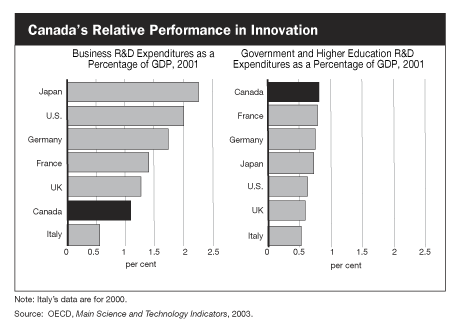
- Innovation is crucial in today’s economy. New ideas are the cornerstone of higher productivity. Innovation is prevalent throughout the economy and so it is difficult to measure. It encompasses not only totally new technologies and goods but also small incremental improvements to existing ways of producing goods.
- One element of measuring innovation is by looking at research and development (R&D) expenditures as a proportion of GDP. Canada undertakes less investment in this area than many other leading countries. Canada has been lagging behind the U.S. for at least two decades. And we also invest less in R&D than other small open economies, such as Sweden and Finland.
- Canada’s relatively weak R&D performance appears to be concentrated in the private sector. Reflecting large investments by governments since 1997, Canada’s universities and public sector undertake a significant amount of R&D measured as a proportion of GDP.
- Recent corporate tax cuts, together with the already very generous scientific research and experimental development (SR&ED) investment tax credit and the expanding research base available in Canada, should therefore help encourage greater business R&D investment.
ICT-related technological transformation shows how the drivers of growth interact to foster higher productivity in Canada
Labour Productivity Growth
by ICT Intensity in Canada
|
||||||||||||||||||||||||||||||||||||||||
- There is growing evidence that investment in information and communications technologies (ICT) has played a crucial role in the improved productivity performance of some countries, particularly the United States, since the mid-1990s.
- A critical driver of improved productivity growth has been the increased use of ICT, accompanied by a rethinking of how work is done. In other words, investment in ICT (or M&E investment more generally), embodying the latest innovations (R&D), and used by skilled workers (human capital), have led to significantly higher productivity growth.
- The same story as in the U.S. has held true here in Canada since 1997, as productivity gains have been concentrated in ICT-intensive sectors, notably in services.
- Public policies implemented since the mid-1990s have facilitated Canada’s improved growth in productivity and standard of living. Increased rates of capital cost allowances for ICT investment, introduced in this budget, provide further impetus for ICT investment. The success of this productivity-enhancing approach needs to be borne in mind in looking ahead.
Productivity growth can be enhanced by sound macroeconomic policy …
- Sound macroeconomic policy is the key ingredient in a productivity-enhancing strategy. It helps to keep interest rates low and reduces uncertainty in the economy. This in turn encourages investment in human and physical capital and innovation, and therefore boosts productivity growth.
- In the last decade, Canada has developed a sound macroeconomic policy framework which needs to be maintained and enhanced.
|
Key Factors in Canada’s Macroeconomic Policy Framework Low inflation In 1991 the Bank of Canada and the Government agreed to adopt inflation targets. In 2001 the inflation target range of 1 to 3 per cent was extended until 2006. Canada has achieved one of the lowest and most stable inflation regimes in the world over the past decade. Prudent fiscal planning and balanced budgets Prudent fiscal planning and sound financial management turned chronic government deficits into six consecutive years of budget surpluses through 2002–03. The Government is committed to maintaining this prudent approach to fiscal planning: maintaining balanced budgets or better and a reducing debt burden. Declining debt-to-GDP ratio The federal debt-to-GDP ratio is on a permanent downward path—it has fallen from 68 per cent in 1995–96 to 44 per cent in 2002–03. In this budget the Government has committed to lowering the federal debt-to-GDP ratio to 25 per cent within 10 years. |
… and sound microeconomic policy
- While a sound macroeconomic policy is essential to a productivity-enhancing policy framework, it must be complemented with microeconomic policies that reflect best practices. The right microeconomic framework encourages and supports investment in the drivers of growth.
|
Key Factors in Canada’s Microeconomic Policy Framework Support for learning
Encourage research and development
A competitive tax structure
Efficient financial markets
Trade liberalization and attracting foreign investment
Efficient design of social policies
Support for communities
|
1 This annex incorporates data available up to March 9, 2004. [Return]
2 Since productivity is best measured by real GDP per hour, changes per capita also depend on changes in hours per worker. The trend towards fewer hours per worker over recent decades in most industrialized counties, particularly in Europe and Japan, has exerted downward pressure on GDP per capita growth. This effect is, however, very small for Canada (and the United States) and is therefore ignored in this section for simplicity. [Return]
- Table of Contents - Previous - Next -
|
|
|||||
| Last Updated: 2004-03-23 | |||||